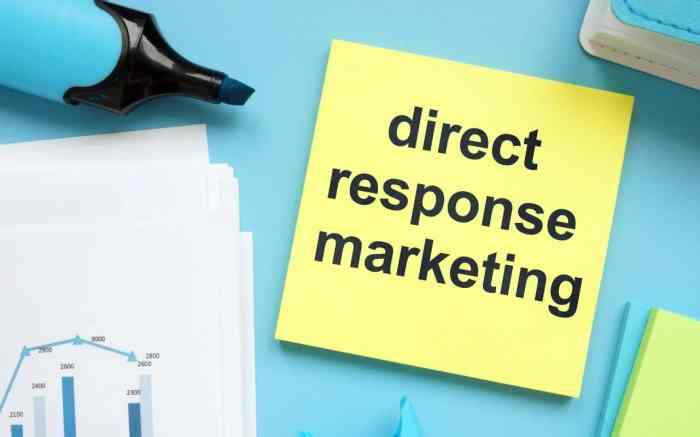
Delve into the world of direct response marketing where strategies reign supreme, benefits abound, and seamless integration is the key to success. Brace yourself for a journey filled with insights and tips to elevate your marketing game!
Direct response marketing is a powerful tool that can revolutionize the way businesses connect with their audience, driving engagement and boosting sales like never before.
Definition of Direct Response Marketing
Direct response marketing is a strategy that allows businesses to interact directly with consumers and prompt them to take immediate action, such as making a purchase, signing up for a newsletter, or requesting more information. Unlike traditional marketing approaches that focus on building brand awareness over time, direct response marketing aims to generate instant responses from the audience.
Key Characteristics of Direct Response Marketing
- Measurable Results: Direct response marketing campaigns are designed to track and measure the responses and outcomes, allowing businesses to assess the effectiveness of their strategies.
- Call to Action: Every direct response ad or message includes a clear and compelling call to action, prompting the audience to take a specific step.
- Targeted Audience: Direct response marketing targets a specific audience segment with personalized messages to increase the chances of a response.
- Immediate Response: The goal of direct response marketing is to elicit an immediate response from the audience, whether it’s making a purchase or requesting more information.
How Direct Response Marketing Differs from Other Marketing Strategies
- Focus on Action: Unlike branding or awareness campaigns, direct response marketing focuses on driving immediate actions from the audience.
- Measurable ROI: Direct response marketing allows businesses to track the return on investment (ROI) of their marketing efforts more accurately compared to traditional methods.
- Personalization: Direct response marketing often involves personalized messages tailored to the specific needs and preferences of the target audience.
- Quick Feedback: With direct response marketing, businesses can quickly gather feedback and insights from the audience’s responses, enabling them to make timely adjustments to their campaigns.
Strategies for Direct Response Marketing

Direct response marketing is all about encouraging immediate action from the target audience. To effectively implement this type of marketing, businesses need to utilize various strategies to drive response rates and achieve their goals. Let’s explore some effective strategies for direct response marketing:
Importance of a Strong Call to Action
A strong call to action (CTA) is crucial in direct response marketing as it tells the audience exactly what they need to do next. Whether it’s making a purchase, signing up for a newsletter, or requesting more information, a clear and compelling CTA motivates people to take action. Examples of effective CTAs include “Shop Now,” “Sign Up Today,” or “Learn More.”
Creating Compelling Offers
To drive response rates in direct response marketing, businesses need to create compelling offers that entice the audience to act quickly. This could include limited-time discounts, free trials, exclusive deals, or special promotions. By offering something of value to the audience, businesses can increase the likelihood of a response.
Benefits of Direct Response Marketing
Direct response marketing offers numerous advantages for businesses looking to boost their sales and reach their target audience effectively. Let’s explore some of the key benefits below.
Increased ROI
Direct response marketing typically yields a higher return on investment compared to traditional forms of marketing. By targeting specific segments of the market with personalized messages and calls to action, businesses can generate more leads and conversions, resulting in a higher ROI.
- Targeted Approach: Direct response marketing allows businesses to target their messaging towards specific demographics, interests, and buying behaviors, increasing the likelihood of conversions.
- Measurable Results: Unlike traditional marketing methods that may be harder to track, direct response marketing provides clear metrics to measure the success of campaigns, allowing businesses to optimize their strategies for better results.
- Cost-Effective: With direct response marketing, businesses can reach their target audience without the high costs associated with mass marketing campaigns, making it a more budget-friendly option for many companies.
Success Stories
Many companies have found great success with direct response marketing, showcasing the power of this approach in driving sales and customer engagement. One notable example is XYZ Company, which increased their online sales by 40% after implementing a direct response marketing campaign that targeted their most valuable customers with personalized offers and incentives.
“Direct response marketing has been a game-changer for our business, allowing us to connect with our customers on a deeper level and drive significant growth in sales,” said the marketing director of XYZ Company.
Integration with E-Commerce

Direct response marketing can be seamlessly integrated with e-commerce platforms to drive online sales and maximize conversion rates. By utilizing targeted messaging and strategic tactics, businesses can effectively engage with their target audience and encourage immediate action.
Tips for Leveraging Direct Response Marketing to Boost Online Sales
- Utilize compelling call-to-action buttons on your website to prompt visitors to make a purchase or sign up for a newsletter.
- Implement personalized email marketing campaigns based on customer behavior and preferences to increase engagement and drive sales.
- Create targeted social media ads that lead users directly to your e-commerce site, highlighting special offers or promotions to entice potential customers.
- Optimize your website for mobile devices to ensure a seamless shopping experience for users on smartphones and tablets.
Role of Targeted Messaging in E-Commerce Direct Response Campaigns
Targeted messaging plays a crucial role in e-commerce direct response campaigns by tailoring content to specific customer segments based on their demographics, behaviors, and interests. By delivering personalized messages that resonate with individual users, businesses can enhance customer engagement and drive higher conversion rates. Whether through email marketing, social media advertising, or website content, targeted messaging allows brands to connect with their audience on a more personal level, ultimately leading to increased sales and brand loyalty.
Direct Response Advertising
Direct response advertising is a form of marketing that aims to elicit an immediate response from the consumer, typically in the form of a purchase or inquiry. Unlike traditional advertising methods that focus on building brand awareness over time, direct response advertising seeks to prompt an immediate action from the audience.
Relationship between Direct Response Marketing and Advertising
Direct response advertising is a key component of direct response marketing. While direct response marketing encompasses a broader strategy of engaging with customers and prospects through various channels, direct response advertising specifically focuses on using targeted messages and calls to action to generate a direct response from the audience.
Differences from Traditional Advertising
- Direct response advertising is highly measurable, allowing marketers to track the effectiveness of their campaigns in real-time through metrics such as response rates, conversion rates, and ROI.
- Traditional advertising, on the other hand, often relies on more subjective measures like brand awareness and recall.
- Direct response advertising typically includes a clear call to action, such as “Call now” or “Visit our website,” prompting immediate engagement from the audience.
- Traditional advertising may focus more on storytelling and brand building, with less emphasis on driving immediate action.
Examples of Successful Direct Response Advertising Campaigns
- The “Dollar Shave Club” viral video campaign, which quickly gained traction and led to a significant increase in subscriptions.
- The “Old Spice” commercials featuring the “Old Spice Guy,” which not only went viral but also resulted in a substantial boost in sales for the brand.
- The “Snuggie” infomercials that turned a seemingly simple product into a cultural phenomenon through direct response advertising tactics.
Affiliate Marketing in Direct Response Strategies
Affiliate marketing plays a crucial role in enhancing direct response marketing efforts by leveraging partnerships with third-party websites or individuals to promote products or services. This collaborative approach allows businesses to reach a wider audience and drive more conversions through a performance-based model.
Benefits of Incorporating Affiliate Marketing
- Affiliate marketing can help expand reach: By partnering with affiliates, businesses can tap into new audiences that they may not have been able to reach on their own.
- Cost-effective strategy: Since affiliate marketing is performance-based, businesses only pay for actual sales or leads generated, making it a cost-effective marketing solution.
- Increased credibility: Affiliates can help build trust and credibility for a brand by endorsing products or services to their own followers and networks.
- Enhanced and online presence: Affiliate partnerships can also contribute to improved search engine rankings and online visibility through backlinks and referral traffic.
Tips for Managing Affiliate Partnerships
- Choose the right affiliates: Select partners whose audience aligns with your target market to ensure relevance and better results.
- Provide clear guidelines: Communicate expectations, promotional strategies, and brand messaging to affiliates to maintain consistency and brand integrity.
- Track and analyze performance: Monitor affiliate activities, track conversions, and analyze data to optimize campaigns and maximize ROI.
- Reward and incentivize: Offer competitive commissions, bonuses, or incentives to motivate affiliates and encourage them to drive more sales or leads.
Importance of Branding in Direct Response Marketing
Branding plays a crucial role in direct response marketing campaigns as it helps create a strong and recognizable identity for a company or product. By establishing a brand, businesses can build trust and credibility with their target audience, making it more likely for consumers to respond to their direct marketing efforts.
Role of Branding in Direct Response Marketing Campaigns
Branding sets the tone for direct response marketing campaigns by shaping the way consumers perceive a company or product. A well-defined brand identity can help differentiate a business from its competitors and make it stand out in a crowded marketplace. This, in turn, can increase the effectiveness of direct response initiatives by creating a connection with consumers and driving engagement.
- Branding helps establish trust and credibility with consumers, making them more likely to respond to direct marketing messages.
- A strong brand identity can increase brand recognition and recall, leading to higher response rates for direct response campaigns.
- Branding sets the foundation for building long-term relationships with customers, fostering loyalty and repeat business.
Impact of Brand Awareness on Direct Response Initiatives
Brand awareness is essential for the success of direct response marketing initiatives as it influences consumer behavior and purchasing decisions. Companies with high brand awareness are more likely to attract and retain customers through their direct marketing efforts. By leveraging brand recognition, businesses can drive conversions and achieve their marketing objectives more effectively.
- Increased brand awareness can lead to higher response rates and conversion rates for direct response campaigns.
- Brands with strong awareness have a competitive advantage in the marketplace, making it easier to attract new customers and retain existing ones.
- Positive brand associations can enhance the perceived value of a product or service, making it more appealing to consumers and driving sales.
Examples of Companies Using Branding in Direct Response Strategies
Several companies have successfully integrated branding into their direct response marketing strategies to drive engagement and generate results.
- Apple: The tech giant has built a powerful brand image that resonates with consumers, leading to high response rates for its direct marketing campaigns.
- Coca-Cola: With its iconic logo and brand messaging, Coca-Cola has maintained strong brand awareness, driving consumer engagement through direct response advertising.
- Nike: By leveraging its brand identity and storytelling, Nike has effectively used direct response marketing to connect with its target audience and drive sales.
Utilizing Mailing Lists for Direct Response
Direct response marketing heavily relies on the effectiveness of mailing lists to reach out to potential customers and drive conversions. Mailing lists play a crucial role in targeting specific audiences with personalized messages, ultimately leading to higher response rates and increased sales.
Significance of Mailing Lists in Direct Response Marketing
Building and maintaining a quality mailing list is essential for the success of direct response campaigns. By segmenting the list based on demographics, behaviors, and preferences, marketers can tailor their messages to resonate with the recipients, increasing the chances of conversion.
Tips for Building and Segmenting Effective Mailing Lists
- Offer incentives: Encourage website visitors to sign up for your mailing list by offering exclusive discounts, freebies, or valuable content.
- Segment based on behavior: Divide your list into segments based on past purchases, engagement levels, or browsing history to send targeted messages.
- Regularly clean your list: Remove inactive or unsubscribed contacts to ensure that your messages are reaching an engaged audience.
Best Practices for Leveraging Mailing Lists to Drive Direct Response Results
- Personalize your emails: Address recipients by their name and tailor the content based on their preferences to increase engagement.
- Create compelling subject lines: Grab the attention of the recipients with intriguing subject lines that entice them to open the email.
- Include clear call-to-actions: Direct recipients on what action to take next, whether it’s making a purchase, signing up for an event, or visiting your website.
Final Review
As we conclude our exploration of direct response marketing, remember that mastering these strategies can lead to unparalleled success in the competitive landscape of digital marketing. With the right approach, your brand can soar to new heights of profitability and customer satisfaction.
FAQ Summary
What sets direct response marketing apart from other strategies?
Direct response marketing focuses on eliciting an immediate response from the audience, often through a strong call to action, unlike traditional marketing that aims for long-term brand building.
How can businesses benefit from using direct response marketing?
Businesses can enjoy higher response rates, better ROI, and more targeted campaigns by leveraging direct response marketing strategies effectively.
Can direct response marketing be integrated with e-commerce platforms?
Absolutely! Direct response marketing can enhance online sales by providing personalized offers, targeted messaging, and compelling calls to action on e-commerce websites.





